
The Metropolitan line, colloquially known as the Met, is a London Underground line between Aldgate in the City of London and Amersham and Chesham in Buckinghamshire, with branches to Watford in Hertfordshire and Uxbridge in Hillingdon. Printed in magenta on the tube map, the line is 41.4 miles (66.7 km) in length and serves 34 stations. Between Aldgate and Finchley Road, the track is mostly in shallow "cut and cover" tunnels, apart from short sections at Barbican and Farringdon stations. The rest of the line is above ground, with a loading gauge of a similar size to those on main lines. Just under 94 million passenger journeys were made on the line in 2019.

Baker Street is a London Underground station at the junction of Baker Street and the Marylebone Road in the City of Westminster. It is one of the original stations of the Metropolitan Railway (MR), the UK's first underground railway, opened on 10 January 1863.

Amersham is a London Underground station in the market town of Amersham in Buckinghamshire, England which is also used by National Rail services.

Moorgate is a central London railway terminus and connected London Underground station on Moorgate in the City of London. Main line railway services for Hertford, Welwyn Garden City and Stevenage are operated by Great Northern, while the Underground station is served by the Circle, Hammersmith & City, Metropolitan and Northern lines.
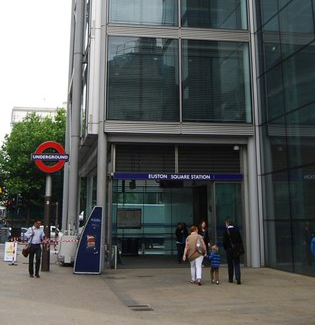
Euston Square is a London Underground station at the corner of Euston Road and Gower Street, just north of University College London – its main (south) entrance faces the tower of University College Hospital. The multi-interchange Euston station is beyond Euston Square Gardens, which is one street east. The station is between Great Portland Street and King's Cross St Pancras stations on the Circle, Hammersmith & City and Metropolitan lines in Travelcard Zone 1.

Chalfont & Latimer is a London Underground and National Rail station in Travelcard Zone 8 on the Metropolitan line, in Buckinghamshire. It also serves the Chiltern Railways line to Aylesbury. Chalfont & Latimer station is located just before the junction for trains to Chesham. The station serves Chalfont St Giles, Chalfont St Peter, Little Chalfont and Latimer. It is located in Little Chalfont. It opened as "Chalfont Road" on 8 July 1889 but changed to the present name from 1 November 1915. The station is a good location to alight from to explore the Chess Valley.
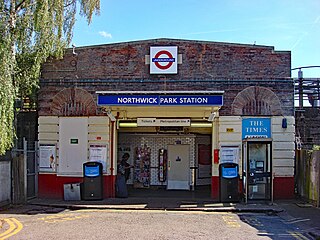
Northwick Park is a London Underground station in Kenton in the London Borough of Brent on the Metropolitan line. It lies between Harrow-on-the-Hill and Preston Road stations and is in Travelcard zone 4. The station takes its name from the nearby public park, Northwick Park.
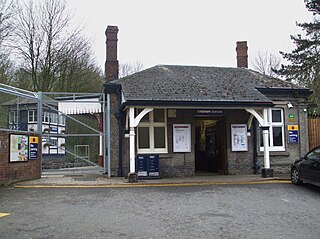
Chesham tube station is a London Underground station in the market town of Chesham in Buckinghamshire, England. It was opened on 8 July 1889 by the Metropolitan Railway (MR). It is the terminus station of the Chesham branch of the Metropolitan line, which runs from Chalfont & Latimer. The station, a Grade II listed building, is in London fare Zone 9.

Chorleywood is a London Underground and National Rail station in Travelcard Zone 7 on the Metropolitan line. The village of Chorleywood is in the Three Rivers district of Hertfordshire about 20 miles (32 km) from London. Chorleywood station is also served by Chiltern Railways, which runs trains from London Marylebone station through to Aylesbury.
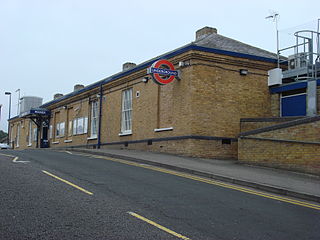
Pinner is a London Underground station. The station was opened in 1885 as part of the Victorian expansion of dormitory suburbs, and was one of the stations included in the Metro-land project in the early 20th century. The site is served by several bus routes including links to the Hatch End railway station which was known as Pinner & Hatch End prior to 1920. Step free facilities were opened in 2008. The station is on the Metropolitan line between Northwood Hills and North Harrow stations, and is in Travelcard Zone 5.
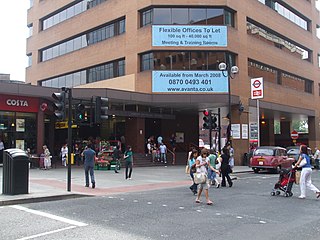
Harrow-on-the-Hill is an interchange railway station in Harrow, served by suburban London Underground Metropolitan line services and commuter National Rail services on the London–Aylesbury line. It is 9 miles 18 chains down the line from London Marylebone. Harrow-on-the-Hill is the final Metropolitan line station from Central London before the line splits with the main branch towards Watford, Chesham or Amersham and the diverged Uxbridge branch towards Uxbridge. It is in Travelcard Zone 5.
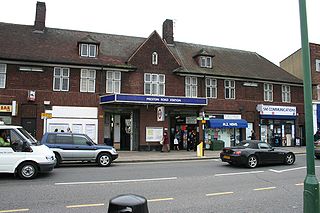
Preston Road is a London Underground station in Preston Road in the London Borough of Brent. It is on the Metropolitan line between Northwick Park and Wembley Park stations and is in Travelcard Zone 4. It serves the local area of Preston in Wembley and parts of Kenton.

Croxley is a London Underground station located on Watford Road (A412) in Croxley Green, Rickmansworth, Hertfordshire, on the Watford branch of the Metropolitan line. It is the only intermediate station on the branch between Watford and Moor Park stations.

Moor Park is a London Underground station in the Three Rivers district of Hertfordshire, serving those living on the Moor Park estate, and also on the neighbouring Eastbury and South Oxhey estates. The station is outside the Greater London boundary but is in both Zone 6 and Zone 7, and is served by the Metropolitan line between Rickmansworth or Croxley and Northwood.

Northwood is a London Underground station on the Metropolitan line between Moor Park and Northwood Hills stations, and in Travelcard Zone 6. The station is located just off the main road through the town, Green Lane. The line serves as the sole continuous link between the town of Northwood and London, key for a region known as Metro-Land.

Aylesbury railway station is a stop on the London–Aylesbury line, serving the town of Aylesbury, Buckinghamshire, England; it is 38 miles (61 km) down the line from London Marylebone. A branch line from Princes Risborough on the Chiltern Main Line terminates at the station. It was the terminus for London Underground's Metropolitan line until the service was cut back to Amersham in 1961. The station was also known as Aylesbury Town under the management of British Railways from c. 1948 until the 1960s.

The London–Aylesbury line is a railway line between London Marylebone and Aylesbury, going via the Chiltern Hills; passenger trains are operated by Chiltern Railways. Nearly half of the line is owned by London Underground, approximately 16 miles (26 km) – the total length of the passenger line is about 39 miles (63 km) with a freight continuation.
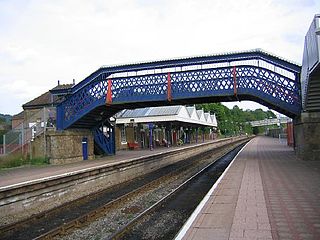
Wendover railway station serves the town of Wendover in Buckinghamshire, England, and villages including Ellesborough and Wendover Dean. The station is on the London Marylebone – Aylesbury line and is served by Chiltern Railways trains. It is between Great Missenden and Stoke Mandeville stations.

Great Missenden railway station serves the village of Great Missenden in Buckinghamshire, England and the neighbouring villages of Prestwood, Little Hampden and Little Missenden. The station lies on the London to Aylesbury Line and is served by Chiltern Railways trains. It is between Amersham and Wendover stations.
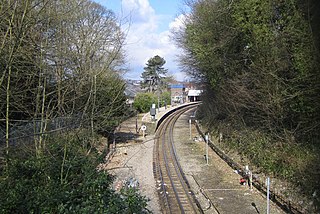
The Chesham branch is a single-track railway branch line in Buckinghamshire, England, owned and operated by the London Underground. It runs from a junction at Chalfont & Latimer station on the Metropolitan line for 3.89 miles (6.26 km) northwest to Chesham. The line was built as part of Edward Watkin's scheme to turn his Metropolitan Railway (MR) into a direct rail route between London and Manchester, and it was envisaged initially that a station outside Chesham would be an intermediate stop on a through route running north to connect with the London and North Western Railway (LNWR). Deteriorating relations between the MR and LNWR led to the MR instead expanding to the northwest via Aylesbury, and the scheme to connect with the LNWR was abandoned. By this time much of the land needed for the section of line as far as Chesham had been bought. As Chesham was at the time the only significant town near the MR's new route, it was decided to build the route only as far as Chesham, and to complete the connection with the LNWR at a future date if it proved desirable. Local residents were unhappy at the proposed station site outside Chesham, and a public subscription raised the necessary additional funds to extend the railway into the centre of the town. The Chesham branch opened in 1889.





















